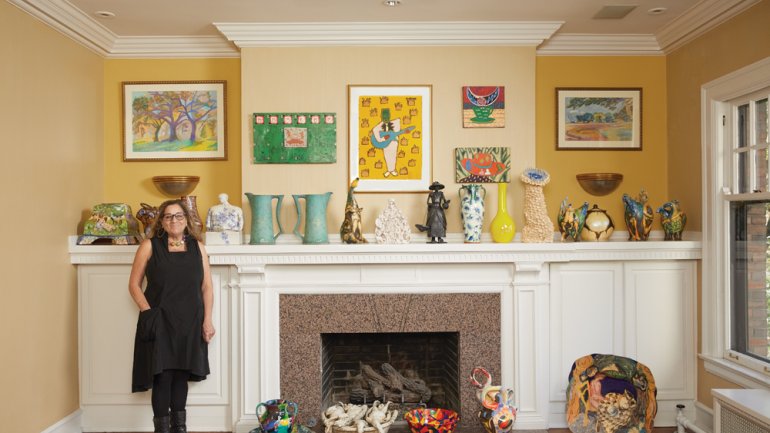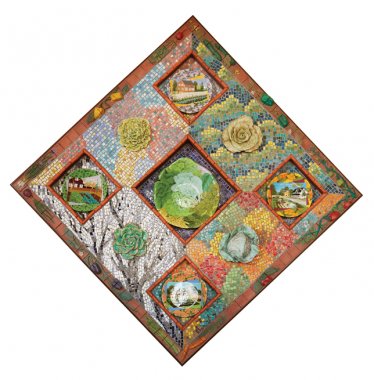Power Broker
Power Broker
“Pottery is the center of my collecting universe,” says Rebecca Sive, a Chicago educator, author, and longtime advocate for women in leadership. Her latest book, Vote Her In: Your Guide to Electing Our First Woman President, was published in October.
Sive and her husband, Steve Tomashefsky, a lawyer, were high school sweethearts in Pearl River, New York, and have developed mutual interests through their intertwined histories, travel, and work. They love the folk art of Brazil, a country they’ve visited several times. Tomashefsky, a birder who as a young man produced blues recordings, owns several John James Audubon paintings and collects books about language and about birds, as well as ephemera from the Chicago blues scene of his youth. Sive collects what she loves – paintings, prints, and especially ceramics, mostly functional pieces.
The couple has a spacious apartment in Chicago, plus a home in southwestern Michigan. “We’re country and city mice both,” Sive says. Many of her ceramic pieces are in the Michigan house (where she also keeps several quilts), but work she treasures brightens every corner of the Chicago space, too.
Why do you collect ceramics?
Growing up in New York, I saw a lot of art. My mother bought some ceramics. I went to Carleton College, near Minneapolis, and while collecting was not a concept I had at the time, as my collecting evolved, I became aware of how wonderful Minnesota is when it comes to clay. I wish everywhere was like it, because ceramics deserves the attention everywhere that it gets in Minnesota. I go there once or twice a year because I have good friends there, and the Northern Clay Center in Minneapolis is a must-stop for me.
Chicago, on the other hand, is not a clay town. That said, I’d like to give a shout-out to the Lillstreet Art Center in Chicago, where Bruce Robbins is CEO. For 40 years, it has produced potters and sold clay pieces, and 99 percent of my early collection came from Lillstreet. I was able to see work there from galleries around the country. I bought this pitcher by Alan Lerner at Lillstreet Gallery probably 25 years ago. He’s from Chicago, a very big talent. He mostly does printmaking now, but when we moved into this apartment, I said to Alan, “I’d like to put your pitcher in a washbasin, but the washbasin has to be a table,” and he made the table to go with the pitcher.
I was trained as a historian, then as a community organizer, and I’ve always been an advocate. That’s what I do. I have many pieces by men, but my focus has always been on women potters, emerging artists who I think are cool. Their work is good and aesthetically significant, and in the collecting process, I am advocating for them. Many of them have had the same struggles as women in other professions. Linda Sikora and Julia Galloway, for example, who now are quite famous, were among the first women ceramics professors [Sikora at New York State College of Ceramics at Alfred University, Galloway at the University of Montana]. All of these women deserve every bit of honor they receive.
You have quite a collection of Linda Sikora’s work.
Yes, 43 pieces. I’m interested in functional work. I’m interested in work by women potters – so Liz Quackenbush, Linda Arbuckle, Sarah Jaeger, Tanya Nehrbass Schulze, whose work I probably have the most of after Linda [Sikora]. What I like about Linda is that she’s really committed to function, but she’s also committed to creating great art. The glaze is great. The shapes are really great, and the technical proficiency is obviously outstanding. You can see over the course of time how the work has evolved.
How do you decide what to collect?
The piece has to speak to me. It tells me a story, and I want to be able to experience that story in my home. But also, I’ve read Ceramics Monthly for 30 years, and I’ve educated myself about the artists whose work appeals to me.
What does it mean to you to have art in your home?
What’s really important to me is that this space is, yes, the home, the hearth, all that kind of thing, but also the warmth and the richness in thought and image and texture. When I look around this room, there’s an installation here of several dozen objects. That’s the main experience and the most important piece to me, creating the space in which these objects rest, and are visible and celebrated.
What do visitors notice?
When they first come in, a lot of people look at the sculpture on the wall by Angelica Pozo, Shrine to the Seasonal Salad. She does a lot of public art, but this piece is about the country and the seasons. You see each of the seasons in the background, and you see them in the colors. Each of the four plates shows a garden of that season. This was probably my first big purchase, and it’s emblematic of what I’m interested in. The work is magnificent, and you can’t miss it. I had a couple of people in here recently who talked about this sculpture in the fireplace, dead birds by Una Mjurka. You have to walk over to the cabinets along the far wall and look a little harder to see works by Beth Lo and Lydia Johnson, but people do.
Do you use the functional pieces in your collection?
I do, as much as possible. In the kitchen, I have nesting bowls by Geoffrey Wheeler that I use all the time, and a Lisa Buck bowl that holds crackers. I broke the spout of a Linda Sikora teapot using it for tea. And I drink my coffee from whatever favorite cup I decide on. I wouldn’t have it any other way. I keep the ones I use in the kitchen, but I have a lot of great cups. I have cups by Joanna Powell, Claire Prenton, Ayumi Horie, so many others. I have a whole cup wall in Michigan, maybe 200 cups. I like to get cups by emerging women potters I think are special. It’s my way of buying work by potters I think are really cool, who are just starting out, when I don’t know yet if I want to purchase something else they’ve done.
What do you see when you’re working at your desk?
I have two walls of ceramics in my office, where I sit all day and write.
What advice would you give to collectors starting out?
Educate yourself. You can’t settle on anything worth collecting, in my view, without understanding what it is and what value it has – its historical and artistic context. And then, be curious, because sometimes a work that other people value won’t appeal to you. I think I’ve shown that you can build a collection with artists who may be less well known but who are equally wonderful. So yeah, be curious, dig deep, think hard. And, unless you have no limit to your pocketbook, you have to be disciplined.
You can live with art. It can be essential to your being and your daily life, whether that’s the coffee pot you use or the space you create in which you live and work.















